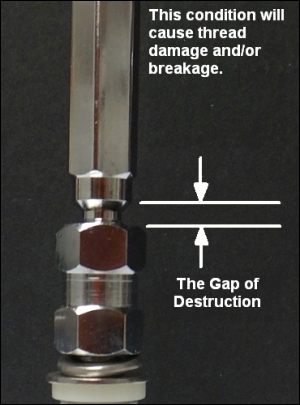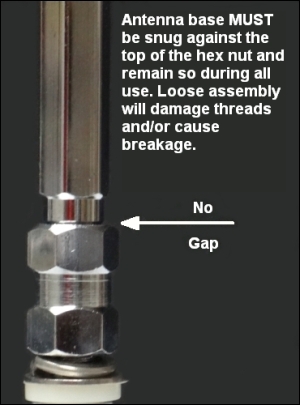

There are four primary installer/user errors that are responsible for over 95% of all incidents where the threaded portion
of the antenna base ends up being sheared from the hexagon portion of the base. In order of most common to least common
1. Failing to use a wrench to tighten the antenna into the stud mount.
While it may be more convenient to just hand screw the antenna into the mount so it can be removed just as easily,
this is the number one reason why antenna threads get broken off. When the antenna is properly secured in the coupling
nut of the antenna stud mount, the stress is transferred to the heavier hex portion of the antenna base. Antennas that
are only hand tightened wiggle loose and as odd as it may seem, have a tendency to turn counter clockwise when moving.
As soon as the contact between the coupling nut and the hex portion of the antenna base loose contact, all of the stress
is absorbed by the weakest part of the antenna base ... namely the threads. And even if the threads do not break off, the
movement of the antenna base inside the coupling nut will damage the threads on both components. DO NOT rely
on hand-tightened antennas. Wrench them together and the likelihood of breakage is nearly non-existent, especially when the
Firestik antenna is mounted via a Firestik stud mount.
2. Insufficient stud mount depth to accept antenna threads
Extreme care must be taken when matching the antenna to the antenna stud. Firestik stud mounts and antenna bases have
mating tapers with slight difference to create a "lug nut" locking effect. This is done to create the best transfer of
stress to the strongest areas of both parts and to prevent self-loosening. Even so, regardless of the antenna stud, the
user/installer MUST make sure that there is enough room (depth) inside the antenna stud to be able to accept the entire
length of antenna base threads. Non-Firestik antenna studs (normally Asian imports) tend to use thin washers and thin,
cheap plastic insulators. And some people, even with Firestik stud mounts leave out pieces. In any case, if the mounting
bolt is allowed to come to far up into the coupling nut, the depth allowed for the antenna threads is reduced. When the
antenna is screwed into the coupling nut the bottom of the antenna base hits the top of the mounting bolt before the base
is seated. Again, if the stress isn't allowed to transfer to the stronger portions of the components, the threads will bear
the stress and could, especially under high wind loads (speed) or on rough terrain, break.
3. Height and velocity challenged individuals
You know ... if you put a 5-foot antenna on a 13-foot high vehicle and then cruise under a 14'6" concrete over-pass doing
65mph, something is going to break. Even so, antennas that were properly tightened into the antenna stud are more likely
to end up with shattered fiberglass than broken threads. Antennas are electro-magnetic radiation devices and are not
designed for, nor should be used to measure the heights or strength of solid objects.
4. Excessive torque used when tightening the antenna
While not as common as the first three items, there are some "if a little is good, a lot is better", folks on the
loose. One of the hardest things to teach anyone is common sense. While many people do fairly well with it, some are
simply clueless. They lay under a 4,000-pound car that is propped up with a $12 jack on a sloped surface; pound nails
with a 20-pound sledgehammer and tighten antennas with a 16" pipe wrench. Short of including some strength reducing drugs
with every antenna, trying to prevent those occasional feats of thoughtless strength would be as futile an effort as putting
up signs demanding common sense be used and expecting the signs to solve the problem. Bottom line ... tighten the antenna
with firmness ... not brutality.
|




